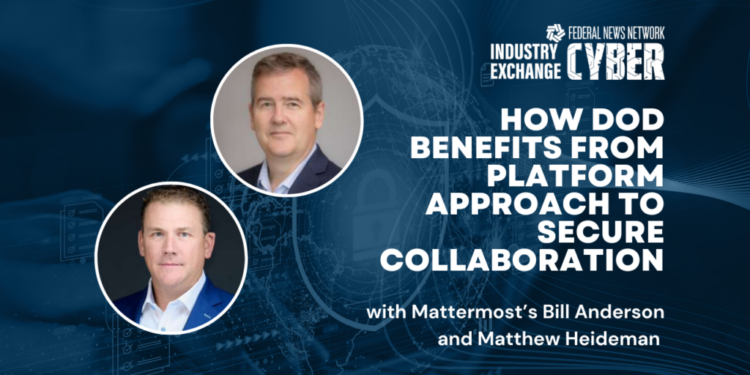
Decision-making in complex environments like the Defense Department requires collaboration among people across a range of functions.
Whether responding to a potential cybersecurity incident, or managing, say, flight operations, people need to communicate and share data from multiple sources. A capable integration platform can enhance decision-making by keeping data and workflows organized and supporting security and access control.
Bill Anderson, principal product manager at Mattermost, put it this way during Federal News Network’s Industry Exchange Cyber 2025: “People who are experts at that subject matter, who make decisions. Where do they make it? They make it in a platform. They talk to each other. They collect the data.”
He added, “They’re people doing work around data streams in a place where they can have a record of it and keep it secure.”
A platform architecture that integrates users and data from the tactical edge, cloud presences and data centers is particularly important for DoD efforts like JADC-2, the Joint All-Domain Command and Communications system.
“Mattermost contributions to that consist of being the connective tissues of information, people and data to deliver the right information at the right time to the person that needs it,” said Matthew Heideman, Mattermost’s vice president for the public sector.
Integrating collaboration, security and functionality
Anderson and Heideman emphasized that cybersecurity must undergird platform functionality.
“DoD in particular has a lot of challenges on the security, the protection, the incident response front,” Anderson said. The challenges stem in part from the sheer volume of information coming at network and security operations people.
“The folks who are working the front end, keeping things secure, or being out there in the field doing their jobs, they’re overwhelmed,” Anderson said. A contributing factor, he said, is the number of tools and associated processes for dealing with different information.
Operators “need to deal with it, but it’s over there in some specialized security tool … and so there’s almost like a perception of a tool tax,” Anderson said. “Disconnected data sources really make that hard.”
Anderson and Heideman said that integrative platforms designed to abstract and simplify data sharing and tool use have special requirements in the DoD context.
“In the DOD, they’ve got another overarching challenge, which is classifications and segmentation,” Anderson said.
Data from classified and merely sensitive sources can’t always be combined. In fact, “knowledge about the data itself, even the names of programs that people are working on can sometimes be classified, and so they have to deal with these security problems,” he said.
Such an environment requires a platform “that can understand access control, authoritative authentication definitions, who’s cleared for what programs,” Anderson said. The platform must be agile because access lists and other factors likely require daily updates.
Enabling virtual collaboration
Beyond that, a collaborative platform must also support a variety of workflows associated with functions such as logistics and software development. In DevSecOps, for example, Anderson said Mattermost’s platform connects “into your GitHub and Jira systems, and hundreds of other ticketing, management and data sources for critical operations.”
He said the Air Force’s Air Mobility Command uses the platform for managing daily flight operations.
“They bring all those bits of information together to a disparate team,” Anderson said, “who sources this, makes decisions, updates status and then can report on the status as that flight moves throughout its program from Point A to Point B.” Should a mid-flight change of plans occur, the platform synthesizes that data and updates users.
If a platform can also maintain records in a secure way, Anderson said, “that’s the sort of platform that starts to be interesting and sophisticated for a DoD-type of user.”
The JADC-2 idea ties together decision-makers on the frontlines of military operations and those behind the lines in cybersecurity, communications and other support functions — and contractors too.
“The security operations center needs to have direct communications with the cyber protection teams that are responding to the tactical edge on these particular challenges,” Heideman said. “The security operations center also needs to communicate with the vendors involved.”
He added, “Being able to identify issues and being able to isolate those issues quickly and then deal with what the response is going to be, really takes that real-time collaboration in order to connect disparate people that may not be on the same network, may not even be in the same organization.”
That leads back to the collaborative platform concept. “There are people, there are processes, there’s data, and then there’s systems,” Anderson said. “They need to get stitched together.”
Heideman said the use of open source components to build the Mattermost platform is a major reason for its flexibility and adaptability.
“It’s all about promoting standardization across open application programming interfaces and the ability to integrate,” he said. “It’s all about being able to integrate systems, integrate disparate pieces of information for that information sharing.”
Heideman added, “Not only is it a secure approach, it also gives [DoD organizations] economies of scale so they can better leverage their investments.”
Discover more articles and videos now on Federal News Network’s Industry Exchange Cyber 2025 event page.
Copyright
© 2025 Federal News Network. All rights reserved. This website is not intended for users located within the European Economic Area.






